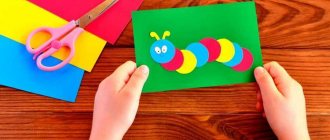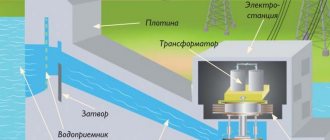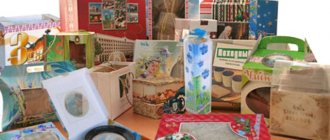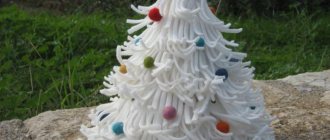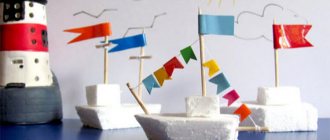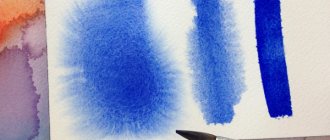Open lesson “Properties of paper”
MUNICIPAL PRE-SCHOOL EDUCATIONAL BUDGETARY INSTITUTION KINDERGARTEN No. 7 OF THE CITY DISTRICT OF THE CITY OF NEFTEKAMSK
Cognitive - research activities in the 2nd junior group “Property of paper”
| Prepared and conducted by teacher II ml. gr. Shaikhutdinova V.A. |
2016
Goals:
Develop the ability to observe and draw conclusions. Introduce children to the properties of paper. During experimental activities, learn to give complete answers. Develop children's thinking and speech. Cultivate curiosity.
Equipment
: box, various types of paper, containers with water.
Progress:
1. Guys, I brought you this box today. Want to see what's inside? What's there? (papers) That's right, there is a lot of paper in the box. Why do we need paper? That's right, you can draw on paper, you can glue it, you can wipe yourself with it. Look, are the papers in the box all the same or are they different? To find out, we will play with them and look at them.
Work at the first table
. Equipment: sets of different papers - landscape sheet, napkin, notebook sheet, pieces of wallpaper, velvet paper, etc.
1.
Look how many different types of paper there are, let's touch and look at them
What does a green piece of paper feel like... (smooth)
How does a red piece of paper feel... (rough)
How does a blue piece of paper feel... (thick)
What does a yellow piece of paper feel like... (thin, soft).
Paper feels different to the touch: smooth, soft, rough, thin, thick, etc.
Look at the color of the paper? (multi-colored.)
Now we will play the d/game “Show me correctly.” Whatever color I name, this is the color of the paper you should lift. Pick up the red, blue, etc. paper.
Guys, is it possible to see anything through paper?
- Take the paper and look through it. Can you see anything?
This means the paper is thick, and nothing can be seen through the paper.
2. “Crinkle and smooth”
You can also wrinkle the paper. Take thin, smooth, white paper and crumple it, like this, and we have a bun, now smooth it out. Happened?
Conclusion: the paper can be wrinkled and smoothed.
Work at the second table.
1.
Equipment: container with water, paper.
- Now take strips of paper and put them in a container of water. What's happening? The paper is wet, try to pick it up. What happened? The paper is torn.
Conclusion: the paper is wet and torn. Paper is afraid of water.
2.
Paper can be torn into small pieces by hand; which paper tears easier: landscape paper or colored paper? Look how many small pieces we got. Do you think we need them? What can you do with them? (glue)
Of course, you can make an applique from small pieces of paper. Look at the drawings I drew for you, do you like it? And I really like them, but if you cover them with our pieces of paper they will become even more beautiful. Today after sleep we will decorate our drawings.
Development of a lesson on the topic: “Paper, its types and properties”
Association: “Creative Workshop”
Head of the association: Medvedeva E.G.
Topic:
Paper, its types and properties.
Target:
familiarization with the types and properties of paper, tools for working with paper.
Tasks:
-introduce students to the history of the appearance of paper, types and properties of paper, tools for working with paper, rules for safe work with tools;
-develop thinking, imagination, fantasy, and speech of students;
- to cultivate hard work, perseverance, accuracy, and respect for nature.
Equipment:
paper samples, task cards, templates, product sample.
Materials and tools:
white cardboard, scissors, colored pencils.
Progress of the lesson:
1. Organizational moment.
Getting students in the mood for work, checking readiness for class.
2.Learning new material.
Paper is the material we will most often work with in class. Today you will learn about what kind of material this is, how it is made, consider the types of paper and its properties. You will also learn about the tools that are used when working with paper.
Let's look at the history of paper. What did people draw on before and with what? With a sharp stone on another stone, with a stick on sand, clay, earth. Why did people draw? This is how people conveyed messages. Primitive people depicted various scenes of their lives on stones, in Ancient Egypt they painted and wrote on the glued stems of a herbaceous aquatic plant papyrus, the ancient Greeks used tablets covered with wax. In eastern countries, silk and clay tablets were used. Our ancestors used birch bark (birch bark), parchment (specially processed cattle hide). The Chinese wrote down thoughts on bamboo tablets, burning out hieroglyphs with a hot awl. Then they began to tie such planks with ropes and it turned out to be a “book”.
Exercise. Game "Complete the figure." Only part of the drawing remains on the rock painting. Draw what it could be.
Later they learned how to make paper. Who knows in what country they learned to make it? Paper was invented in China. From the chronicles it is known that in 105 a man named Cai Lun invented paper. He found a way to make it from the fibrous inner bark of the mulberry tree. For this, the inventor was declared a deity, and a temple was built in honor of this event. Having received recognition, the paper began to be widely used. The method of making paper was kept secret for a long time. Merchants from China gradually spread the paper to other countries. In Europe, paper began to be produced in the 10-11th century, and in Russia in the 16th century. In Russia, a new method of making paper was proposed - from straw. Paper mills gradually appeared.
